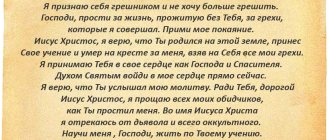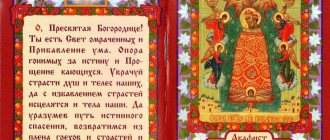Akathist - hymn of praise
In Orthodoxy, an akathist is a special church chant, a kind of hymn of praise. Initially, this chant was dedicated to the Mother of God. Only it was called an akathist. The word “akathist” is translated from Greek as “unsaddled song,” that is, “a hymn that one does not sit while singing.” This has to do with the practical “fulfillment” of akathists to this day. In this regard, this chant differs from kathisma, that is, prayer reading, during which one is allowed to sit. Prayers before the akathist should prepare a person’s soul.
Based on the name itself, the Akathist is read standing. But for health reasons, an exception is made for those people who cannot stand. The Akathist can be read by both clergy and every believer.
Believers in an Orthodox church
Execution order
The main rule when performing this prayer is to strictly adhere to the order in which the ikos and kontakia occur. You cannot start reading from any place, since this would contradict the order of presentation. Since the structure of this prayer is very rigid and unchanging, and there is a canon according to which these works of church poetic art are composed to this day, it is necessary to strictly follow it.
It is also believed that before reading the akathist it is necessary to say a special pre-reading prayer. If a person has pure thoughts and opens his heart to God’s grace, he can only read the akathist himself directly - this is not prohibited by the church. But if you want everything to be according to the rules, then you should not neglect the pre-reading prayer and the prayer that is read after the song of praise itself.
What is an akathist in Orthodoxy?
There is no historically confirmed information about the author of the first akathist. How, according to Tradition, the pious desire of Christians to paint the image of the Mother of God was fulfilled by the Apostle Luke. Someone had to fulfill the desire that arose in the souls of believers to praise the Most Holy Theotokos with a hymn of thanksgiving. Church historians name the Venerable Roman the Sweet Singer (6th century) as a possible author.
As Tradition says, by special heavenly inspiration he wrote the first kontakion in honor of the Feast of the Nativity of Christ. On the eve of the Feast of the Nativity of Christ, the Mother of God appeared to the Monk Roman in Constantinople in a dream vision. She ordered to eat the parchment scroll. When the monk woke up, he ascended to the pulpit (an elevated place in the church) and began to proclaim:
“Today a virgin gives birth to the Most Essential, and the earth brings a den to the Unapproachable: angels with shepherds glorify, while wolves travel with a star: for for our sake the Young Child, the Eternal God, was born.”
Centuries later (13th century), similar hymns were written to the Lord, various icons of the Mother of God, Angelic powers and holy saints of God. Thus, the akathist turned into a special genre of church chants.
The authors of ancient akathists are often unknown. New songs of praise are being written right up to the present time. The desire to express feelings through an akathist testifies to the need of the Christian soul to bring praise and thanksgiving for the help provided.
“Thanksgiving to the one who receives gifts encourages the One who gives gifts to give even other gifts, greater than the first. Gifts remain without multiplication only when there is no thanksgiving for them” (St. Ignatius Brianchaninov, 1807-1867).
Akathist to the Guardian Angel
Every Christian has a Guardian Angel, which is given to him during the sacrament of Baptism. A person can turn to his Angel for help at any time.
The Akathist to the Guardian Angel should be read every week. This is usually done at the beginning of the week, namely on Monday. By chanting the Guardian Angel, a person expresses his gratitude and respect to him.
Akathist structure
The structure of the akathist includes 12 ikos and 13 kontakia, alternating with each other. The Ikos contain 12 hayretisms (greetings beginning with the Greek word "χαῖρε" - "rejoice"), which follow a short introductory part of the main text. It should be noted that the Russian translation of “rejoice” is not a literal call to joy. The meaning of this word in this case is as a greeting. Preface the reading of prayers before the akathist.
The rhythmic pattern is clearly expressed in the ikos. Hairetisms are combined into 6 pairs in such a way that in each pair one line mirrors the other. They contain paired rhyme: each word in one line is rhymed with its corresponding word in the other.
A short ikos in the Slavic tradition is called a kontakion. At the end of it, the refrain “Hallelujah” (“praise God”) is sung. The text of the kontakion itself reveals the meaning of the holiday. Thus, in the Akathist to the Most Holy Theotokos in Kontakion 2 it is sung:
“Seeing the Holy One in purity, he says to Gabriel boldly: the glorious thing of your voice is inconvenient to my soul: the birth of a seedless conception, as you say...”.
What is an akathist and when is it read?
Akathists are poetic works, solemn chants offered in honor of Jesus Christ, the Mother of God or the Saints.
Such hymns have a special structure; each akathist includes 25 songs, all of them arranged in the order of the Greek alphabet. These songs, in turn, are further divided into kontakia and ikos.
A kontakion is a short song of praise that describes an event or deed associated with a saint. The kontakion ends with the words “Hallelujah,” which translated from Hebrew means “praise God.” There are 13 kontakia in the Akathist.
Ikos is a lengthy song; it reveals the event being sung in more detail. The song ends with the word “Rejoice.” The Akathist includes 12 ikos. Kodaks and Ikos alternate.
When is the akathist read?
The reading of the akathist is not a statutory, obligatory liturgical rite. In the church there is only the reading of the Akathist to the Most Holy Theotokos “To the Mounted Voivode...” on the Feast of the Praise of the Most Holy Theotokos (Saturday of the fifth week of Great Lent).
The Church has not established any other specially designated time for reading the akathist. Nor have special prayers been compiled before the akathist. Everyone can resort to singing thanks and praise according to the desire of their soul. As Archimandrite Kirill Pavlov (1919-2017) said:
“Not to see all the blessings of God means not to be aware of one’s very existence, not to feel one’s own life, to become a completely stone, insensitive and lifeless person... Nature itself draws our heart to gratitude to its benefactor. After all, both dumb animals and wild animals express, as best they can, their gratitude to the person who benefits them.”
You can read akathists for everyday needs, calling on the saints for help.
“Like a song imbued with the spirit of cheerfulness and joy, the akathist is attractive to every prayer-minded soul... In each akathist there are several strong expressions that poured out from the depths of the author’s heart, and they, like a ray of grace, will sink into the depths of the hearts of those praying, especially those thirsting for encouragement and consolation” ( professor, doctor of theology Alexey Vasilievich Popov, 1856-1909).
Why do they read the akathist?
Photo: Bogo.rf
Usually Christians praise or thank Jesus Christ, His Most Holy Mother, and ask for mercy and protection in life from the Heavenly Saints:
- about help in conceiving a long-awaited child;
- about a quick and easy resolution of pregnancy;
- about the happiness of children and grandchildren;
- about the rapid extermination of diseases;
- about getting rid of addictions: alcoholism, drug addiction, gambling addiction;
- the end of hostilities and the return of defenders home alive;
- about the cessation of painful mental grief;
- about getting rid of poverty;
- about a decent way out of difficult situations (in life, at work, in the family).
Believers notice that after reading the akathist, “magical” things happen to them:
- when turning to Christ, the soul brightens, darkness and the burden of problems leave it, it is filled with joy and happiness, and the person himself is ready to sing and fly from the lightness that has visited him;
- when reading the akathist every day, the worshiper quickly understands the text of the prayer and Biblical events;
- after reading (singing) the doxology, all doubts about the successful outcome of the planned matter go away.
The appeal to Heaven is greatly enhanced by prayer by agreement - the collective performance of the akathist. Relatives and friends, and even just acquaintances, living in different cities of the country and distant corners of the planet at a strictly defined time begin to read (sing) a certain akathist.
Prayers before reading the akathist
Before reading the akathist, it is necessary to read the initial prayers, as at the beginning of the main prayers or before starting a new task. There are no special prayers for this occasion. Reading the akathist can be combined with reading the morning or evening prayer rules. Then the opening prayer before the akathist is not read. Prayers before the akathist are needed to “warm the heart” and prepare the soul for doxology and thanksgiving.
At the end of the akathist, a prayer is read.
Initial prayers before the akathist
Through the prayers of the saints, our fathers, Lord Jesus Christ our God, have mercy on us. Amen.
Glory to Thee, our God, glory to Thee
Heavenly King, Comforter, Soul of truth, Who is everywhere and fulfills everything, Treasure of good things and Giver of life, come and dwell in us, and cleanse us from all filth, and save, O Good One, our souls.
(From Easter to the Ascension, instead of this prayer it is read: “Christ is risen from the dead, trampling down death by death, and giving life to those in the tombs” (three times). From the Ascension to Trinity, it is not read at all.)
Holy God, Holy Mighty, Holy Immortal, have mercy on us. (Thrice)
Glory to the Father and the Son and the Holy Spirit, now and ever and unto ages of ages. Amen.
Most Holy Trinity, have mercy on us; Lord, cleanse our sins; Master, forgive our iniquities; Holy One, visit and heal our infirmities, for Thy name's sake.
Lord have mercy. (Three times).
Glory to the Father and the Son and the Holy Spirit, now and forever and unto ages of ages. Amen.
Our Father…
Come, let us worship our King God. (Bow)
Come, let us worship and fall down before Christ, our King God. (Bow)
Come, let us bow and fall down to Christ Himself, the King and our God. (Bow)
Psalm 50
Symbol of faith
Closing Prayers
After completing the reading, you need to say a short prayer:
It expresses praise to the Mother of God, the Lord, the Holy Spirit, hope for salvation, a prayer of repentance is said 3 times.
Prayers before and after reading the akathist are very important for a person who decides to touch the Orthodox faith. But they must be read carefully and correctly so as not to distort the meaning of the words. Otherwise, there will be no benefit to the soul.
Prayers after reading the akathist
It is worthy to eat as truly to bless Thee, the Mother of God, the Ever-Blessed and Most Immaculate and the Mother of our God. The most honorable cherub and the most glorious seraphim without comparison, who without corruption gave birth to God the Word, the real Mother of God, we magnify Thee.
(From Easter to Ascension, instead of this prayer, the chorus and irmos of the 9th song of the Easter canon are read:
The angel cried out with grace: Pure Virgin, rejoice! And again the river: Rejoice! Your Son is risen three days from the grave and raised up the dead; people, have fun! Shine, shine, new Jerusalem, for the glory of the Lord is upon you. Rejoice now and be glad, O Zion. You, Pure One, show off, O Mother of God, about the rise of Your Nativity)
Glory to the Father and the Son and the Holy Spirit, now and ever and unto ages of ages. Amen.
Lord have mercy. (Three times).
Lord Jesus Christ, Son of God, prayers for the sake of Your Most Pure Mother, our reverend and God-bearing fathers and all the saints, have mercy and save us sinners, for you are Good and Lover of Mankind. Amen.
How to correctly read the akathist in front of the “Inexhaustible Chalice” icon at home
The “Inexhaustible Chalice” is an icon of the Most Holy Theotokos, which has healing properties. In front of this holy image, mothers pray for their drinking sons and daughters, wives for their husbands, and the believers themselves, who want to get rid of this illness, ask for help from the Most Holy Theotokos.
The Akathist is read standing in front of the “Inexhaustible Chalice” icon. The head should be cleared of extraneous thoughts. Thoughts should be bright and pure, the soul should be full of faith in God.
What is the difference between a canon and an akathist?
The canon and akathist are solemn chants in honor of the Saints. The canons sing of Old and New Testament events, while the akathist only sings of New Testament events.
The canons were written exclusively by the holy fathers; individual akathists were written by ordinary laymen.
The canon includes 8 songs. Canons can be sung all year round; akathists are not sung on days of fasting, with the exception of Sundays.
In addition, the order of singing the canons is established by the Church. They are sung in accordance with a precise schedule, but a person orders akathists at his own discretion.










